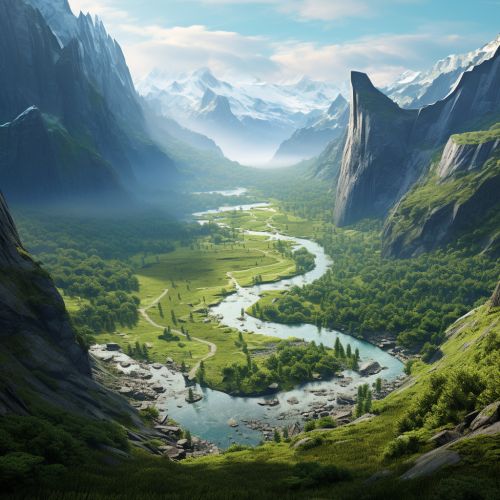Glacial valley
Overview
A glacial valley, also known as a U-shaped valley, is a specific type of valley formed by the erosive actions of glaciers. They are characterized by their U-shape, with steep, straight sides and a flat or rounded bottom, which contrasts to the V-shape of river valleys. Glacial valleys are formed when a glacier erodes the landscape over thousands to millions of years, carving out a valley in the process.


Formation
The formation of a glacial valley begins with a glacier, a large, slow-moving mass of ice that forms over many years through the accumulation and compaction of snow. Glaciers move under their own weight, and as they move, they erode the underlying rock. This process, known as glacial erosion, is the primary mechanism for the formation of glacial valleys.
Glacial erosion involves two main processes: abrasion and plucking. Abrasion occurs when the glacier grinds against the bedrock, wearing it away. This is facilitated by the debris embedded in the ice at the base of the glacier. Plucking, on the other hand, occurs when the glacier freezes onto the bedrock and, as it moves, it pulls out large chunks of rock. These processes together carve out the valley, with the glacier acting like a giant bulldozer.
Characteristics
Glacial valleys are distinct from other types of valleys due to their U-shape. This shape is a result of the glacier's size and its erosive power. Glaciers are wider than rivers and thus erode a broader path. Furthermore, glaciers erode the valley sides as well as the floor, leading to the steep sides characteristic of glacial valleys.
Another characteristic of glacial valleys is the presence of hanging valleys. These are smaller valleys that join the main valley at a much higher elevation. They are formed by smaller glaciers, known as tributary glaciers, which do not have the same erosive power as the main glacier. When the glaciers melt, these valleys are left 'hanging' above the main valley.
Examples
There are many notable examples of glacial valleys around the world. One of the most famous is the Yosemite Valley in the United States, which was carved out by glaciers during the last ice age. Another example is the Glendalough valley in Ireland, which features a classic U-shaped profile and a beautiful lake formed by glacial action.
Impact on Human Activity
Glacial valleys have had a significant impact on human activity. Their unique shape and the fertile soil they often contain make them ideal locations for agriculture. Many glacial valleys are also home to major cities, such as Seattle, which is located in a glacial valley carved by the Vashon Glacier.
In addition, glacial valleys are often sites of significant tourism due to their natural beauty. Many national parks, such as Yosemite National Park, are located in glacial valleys and attract millions of visitors each year.
